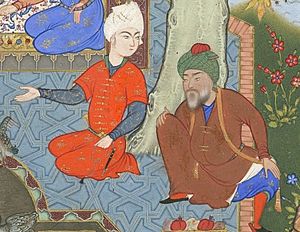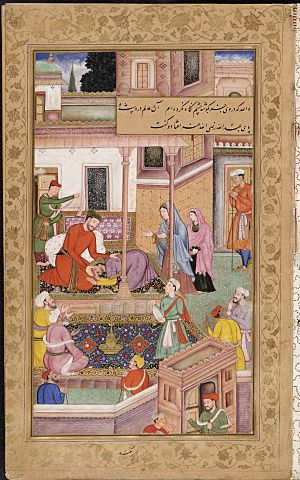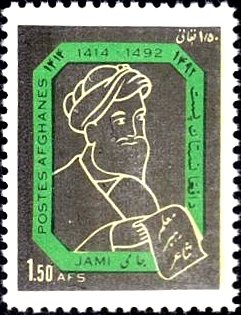Jami facts for kids
Quick facts for kids Mawlanā Jami |
|
|---|---|
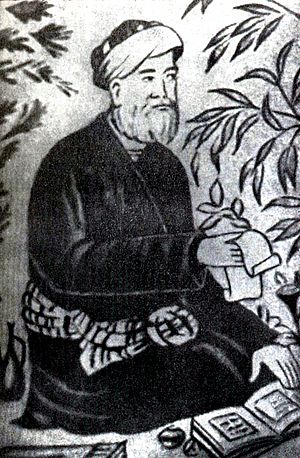
Jami, artwork of Kamāl ud-Dīn Behzād
|
|
| Mystic, spiritual poet, historian, theologian | |
| Born | 7 November 1414 Torbat Jam, Khorasan, Timurid Empire |
| Died | 9 November 1492 (aged 78) Herat, Khorasan, Afghanistan |
| Venerated in | Sunni Islam |
| Influences | Muhammad, Khwaja Abdullah Ansari, Rumi, Ibn Arabi |
| Influenced | Muhammad Iqbal |
|
Tradition or genre
|
Sufi poetry |
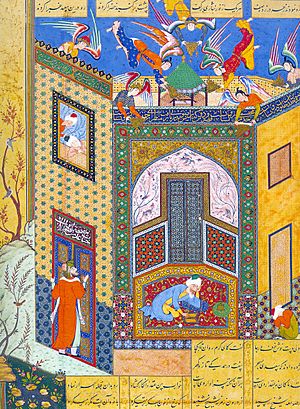
Nūr ad-Dīn 'Abd ar-Rahmān Jāmī (Persian: نورالدین عبدالرحمن جامی; born November 7, 1414 – died November 9, 1492) was a famous Persian poet. He was also known as Mawlanā Nūr al-Dīn 'Abd al-Rahmān or simply Jami. He was a very skilled writer and scholar of Sufi literature. Sufism is a mystical branch of Islam.
Jami was a leading poet and religious thinker. He followed the ideas of Ibn Arabi. He was also a Khwājagānī Sufi. People admired him for his clear writing and his deep thoughts about God's mercy. His most famous poems include Haft Awrang, Tuhfat al-Ahrar, and Layla wa Majnun. Jami was part of the Naqshbandi Sufi group.
Contents
Jami's Life Story
Jami was born in a place called Kharjerd, in Khorasan. His father, Nizām al-Dīn Ahmad, came from a small town near Isfahan. A few years after Jami was born, his family moved to Herat.
Early Education and Studies
In Herat, Jami studied many subjects at the Nizamiyyah University. He learned about Peripateticism (a type of philosophy), mathematics, Persian literature, and natural sciences. He also studied Arabic language, logic, rhetoric, and Islamic philosophy. His father, who was also a Sufi, was his first teacher.
Jami became an important person in the Timurid court in Herat. This meant he was involved in the government, money matters, and religious life of the time. Jami was a Sunni Muslim.
Why He Chose the Name Jami
At first, Jami used the pen name Dashti because his father was from Dasht. But later, he changed it to Jami. He explained why in a poem:
My birthplace is Jam, and my pen
Has ... from (knowledge of) Sheikh-ul-Islam (Ahmad) Jam
Hence in the books of poetry
My pen name is Jami for these two reasons.
So, he chose "Jami" because he was born in Jam and because he learned from a great teacher named Sheikh-ul-Islam (Ahmad) Jam.
Friendships and Family
Jami was a close friend and mentor to the famous Turkic poet Alisher Navoi. Jami wrote about their friendship:
Though he was a Turk, and I am Tajik,
We were close to each other.
After his studies in Herat, Jami went to Samarkand. This city was a major center for science in the Muslim world. He finished his studies there. He also went on a pilgrimage, which made him even more famous across the Persian world.
Jami had a brother named Molana Mohammad, who was a skilled musician. Jami wrote a poem when his brother passed away. Jami had four sons, but sadly, three of them died when they were very young. His only surviving son was Zia-ol-din Yusef. Jami wrote his book Baharestan for this son.
Later Life and Passing
Towards the end of his life, Jami lived in Herat. He passed away in November 1492. His funeral was a very big event, led by the prince of Herat. Many people attended, showing how much he had influenced them. The year of his death was also important because it was when Arabs left Spain after many centuries.
Jami's Teachings and Sufism
Jami became a Sufi shaykh (a spiritual guide) in 1453. He taught many things about following the Sufi path. He was known for being very religious and mystical. He believed in a deep connection with God.
Jami was a strong Sunni Muslim on his Sufi journey. He used ideas of earthly love to describe the spiritual love a person feels for God. He became interested in Sufism when he met Khwaja Mohammad Parsa, who gave him a blessing. Later, he sought guidance from Sa'd-alDin Kasgari after a dream told him to follow God. Jami married Kasgari's granddaughter, which further connected them. He was so dedicated to God that he sometimes forgot about everyday social rules.
After returning to social life, Jami became active in the cultural center of Herat. He worked with the ideas of Ibn Arabi, making them richer and sometimes changing them. Jami believed that God was everywhere and in everything. He also explained important Sufi terms like sainthood and the difference between a Sufi and someone still learning the path.
Jami believed in a complete unity between the lover, the beloved, and the love itself. He thought they were not separate. He was influenced by many earlier Sufi thinkers and added his own new ideas. For Jami, loving Muhammad was the first step on the spiritual journey. He taught many students. Once, a student who claimed he had never loved anyone asked to be his pupil. Jami told him, "Go and love first, then come to me and I will show you the way."
Jami's followers continued his teachings for many generations. He is remembered not only for his poetry but also for his deep knowledge and spiritual traditions in the Persian-speaking world. One of his most important contributions was his explanation of God's mercy towards humans.
Jami's Works
Jami wrote about 87 books and letters. Some of them have been translated into English. His writings include prose (like stories) and poetry. He wrote about everyday topics, religious ideas, history, and science. He also often commented on the works of other religious thinkers, philosophers, and Sufis. In Herat, he even wrote a manual for irrigation design with detailed drawings and calculations. This manual is still used today!
Famous Poetry Collections
Jami's poetry was inspired by the ghazals (a type of poem) of Hafiz. His famous and beautiful collection of poems, Haft Awrang (meaning "Seven Thrones"), was influenced by the works of Nizami.
The Haft Awrang is a collection of seven long poems. Each poem tells a different story. For example, "Salaman va Absal" tells the story of a prince's love for his wet-nurse. Jami used these stories to teach about the Sufi path, like how to ask for forgiveness. He used symbols in his tales to explain philosophical, religious, or ethical questions. Each symbol had a meaning about knowledge and understanding, especially of God. This story showed Jami's idea of a "Sufi-king" as the perfect ruler. This king would follow the Sufi path to become closer to God.
Jami is also known for three collections of lyric poems. These poems show his journey from youth to the end of his life. They are called Fatihat al-shabab (The Beginning of Youth), Wasitat al-'ikd (The Central Pearl in the Necklace), and Khatimat al-hayat (The Conclusion of Life). Sufism and Sufi ideas are key topics throughout Jami's work.
Artwork and Influence
Jami's poetry was so powerful that it influenced Persian paintings. His poems were often included with beautiful Persian miniature paintings in manuscripts. Many of his own books had illustrations, which was not common at the time. The deep meaning in Jami's poetry was often shown through rich paintings, reflecting the beauty of Persian culture.
Jami worked closely with the Tīmūrid court in Herat. He helped as an interpreter and communicator. His poetry showed the spirit of Persian culture and was very popular across the Islamic East, Central Asia, and India. People, both Sufis and non-Sufis, were interested in his work. He was known not only for his poetry but also for his religious writings and comments on culture.
Jami's works were used in schools from Samarqand to Istanbul and in the Mughal Empire. For centuries, Jami was famous for his poetry and deep knowledge. Sadly, in the last 50 years, his works have been less studied, which is a problem for research in Islamic and Persian studies. His poetry even reached the Ottoman Empire because a poet named Basiri moved to Istanbul.
List of Jami's Works
Here are some of Jami's important works:
- Baharestan (Abode of Spring) – This book was inspired by the Gulestan of Saadi.
- Diwanha-ye Sehganeh (Triplet Divans)
- Al-Fawaed-Uz-Ziya'iya – This is a commentary on an Arabic grammar book. It was a main textbook in Ottoman schools.
- Haft Awrang (Seven Thrones) – This is his most important collection of poems. One of the stories is "Yusuf and Zulaykha", which tells the story of Joseph and Potiphar's wife from the Quran.
- Lawa'ih – A book about Sufism (meaning "Shafts of Light").
- Nafahat al-Uns (Breaths of Fellowship) – This book contains biographies (life stories) of Sufi Saints.
- Tajnīs 'al-luġāt (Homonymy/Punning of Languages) – A book about words that sound the same but have different meanings in Persian and Arabic.
- Tuhfat al-ahrar (The Gift to the Noble)
Jami also added to earlier works and inspired new ideas in response to his own.
Legacy
See also
 In Spanish: Jami para niños
In Spanish: Jami para niños


